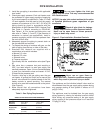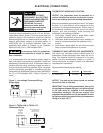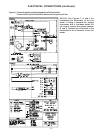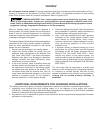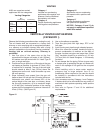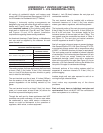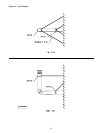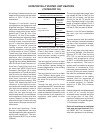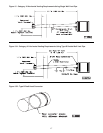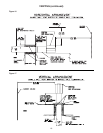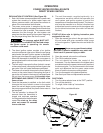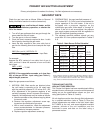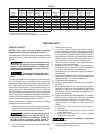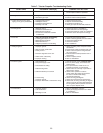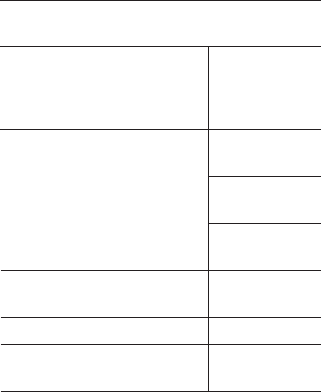
16
HORIZONTALLY VENTED UNIT HEATERS
(CATEGORY III)
All venting of residential tubular unit
heaters must comply with the latest
edition of CSA .10.96 (2
nd
ed.)
requirement.
Category III horizontal venting
arrangements are designed to use
single wall vent pipe. These arrange-
ments must terminate external to the
building using either single wall or
double wall (Type B) vent. See
Figures 15, 16, and 18 for installa-
tion requirements regarding these
venting conditions. If double wall
venting is used, components that
are UL Listed and approved for
Category III positive pressure
venting systems must be used
with one exception: a single 5 foot
(1.52 M) section of 4 inch (102mm)
Type B vent pipe with a draft hood
connector may be used between the
appliance vent connection and
the vent terminal. Use Metalbestos
Type B Gas Vent with a Metalbestos
4RV-DH Draft Hood Connector or
Amerivent Type B Gas Vent with
an Amerivent 4EDC Draft Hood
Connector. See Figure 15A. If using
a single section of Type B vent pipe,
seal the annular space between
the inner and outer sections of the
draft hood connector with high
temperature silicone sealant. See
Figure 15B. Attach the draft hood
connector to the appliance vent
connection with screws and seal the
joint with silicone sealant. Install a
Type B vent thimble in the wall.
Insert the vent pipe through the
thimble and attach it to the adapter
on the appliance. Seal the joint with
silicone sealant or two wraps of
aluminum foil tape. Install a vent cap
on the outlet of the pipe and secure it
with screws.
An Amerivent Americap, Fields
Starcap, or Metalbestos vent cap
must be supplied by the customer for
each power vented unit. The vent
pipe diameter MUST be 4 inches
(102mm).
The venting system for these
appliances shall terminate at least
4 feet (1.2m) below, 4 feet (1.2m)
horizontal from, or 1 foot (0.3m)
above any door, window, or gravity
vent air inlet into the building.
The vent terminal must be at least
12 inches (305mm) from the exterior
of the wall that it passes through to
prevent degradation of the building
material by flue gases.
The vent terminal must be at least
1 foot (305mm) above grade, or in
snow areas, at least 3 feet (1m) above
the snow line to prevent blockage
by snow.
Through the wall vent for these
appliances shall NOT terminate over
public walkways, or over an area
where the condensate or vapor could
create a nuisance or hazard or could
be detrimental to the operation of
regulators, relief valves, or other
equipment.
The vent pipe equivalent length must
not exceed 30 feet (9.14m) for the
30 and 45 unit sizes, and 40 feet
(12.2m) for the 60, 75 and 90 unit
sizes. Equivalent length is the total
length of straight sections PLUS 5
feet (1.52m) for each 90 elbow and
2.5 feet (0.76m) for each 45 elbow.
Maintain 1 inch (25.4mm) between
the vent pipe and combustible
materials.
The vent terminal must be installed
with a minimum horizontal clearance
of 4 feet (1.2m) from electric meters,
gas meters, regulators, and relief
equipment.
Seal all vent pipe joints and seams
to prevent leakage. Use General
Electric RTV-108, Dow-Corning
RTV-732, or equivalent silicone
sealant with temperature rating
of 500°F; or 3M #425 aluminum foil
tape (or equivalent). The vent air
system must be installed to prevent
collection of condensate. Pitch
horizontal pipes downward 1/4 inch
per foot (21mm per meter) toward
the outlet for condensate drainage.
Horizontal portions of the venting
systems shall be supported at
maximum intervals of 4 feet (1.2m)
to prevent sagging (in Canada,
support at 3 feet (1m) minimum
intervals).
Insulate single wall vent pipe exposed
to cold air or running through
unheated areas. Insulate vent pipe
runs longer than 10 feet (3m).
Insulation should be a minmum of
1/2 inch thick foil faced fiberglass,
1-1/2# density insulation.
Each unit must have an individual
vent pipe and vent terminal! Each
unit MUST NOT be connected to
other vent systems or to a chimney.
Door, window or
any gravity air inlet
Forced air inlet within 10 ft.
Adjoining building or parapet
Adjacent public walkways
Minimum
Clearances for
Termination
Locations
Structure
4 feet
below
4 feet
horizontally
1 foot
above
3 feet
above
6 feet
7 feet
above grade
Vent Systems
Termination Clearance Requirements



